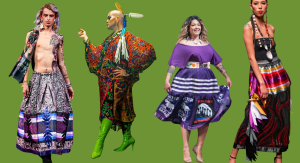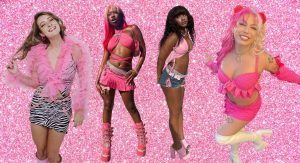As anyone who has ever seen a Medieval painting, or an ancient statue, you may be familiar with the history of people (including men) in robes, dresses, and skirts. Like, duh. The most comfortable, breathable, simple way to clothe oneself! Throughout history, clothes have been just that: fabric that you wear to protect yourself from the elements (or the gaze of others). Ancient Greek soldiers wore skirt-like garments to battle; South Asian peoples are famous for their sarongs and other types of wraps; Scottish heroes vanquished their enemies in kilts. So, at what point did the universal skirt become a symbol of the “modern woman?”

TLDR, gendered clothing as we know it today started in the 19th century, for a variety of reasons. Previously, differences in dress primarily distinguished between social classes. Over time and with new technological advancements, seamstresses and tailors began to focus more exclusively on “womens” and “mens” clothing, creating distinct aesthetics for each sex. Thus, as gender became a more important societal construct, dress became a gender marker as well. It’s important to note that the rise of strict gender roles comes from the (false!) eugenic theory that the sexes become “more distinct” from one another as the society becomes more civilised, but we’ll be talking about that later. The societal construct of binary genders and the dress that visually enforced this binary developed synergistically.

Gender is a social construct that involves norms for behaviour, access to power, and (now) dress. Biological sex refers to one’s sex chromosomes and structures — the most common biological sexes are male, female, and people with a mix of both organs fall into the intersex category. In recent history, biological sex has been used to determine gender, effectively putting a constraint on gender identity (which is ridiculous, given that society can construct gender however we’d like!). Gender expression is the public mannerisms, dress, aesthetic preferences, etc, that one adopts. This can be aligned with one’s gender, or can vary depending on taste, comfort, and often (unfortunately) safety.

So, if we know that biological sex does NOT determine gender, and gender doesn’t always determine gender expression, then you might be led to ask why biological sex dictates our clothes. After all, a t-shirt is not sentient; it is not biologically one sex or another. It’s just an item of clothing. For people. To wear. On their bodies. Like they were invented for. But instead, clothes have taken on social signals associated with gender, which can give and take away perceived power. After all, a woman wearing trousers adopts the cultural power that those trousers carry as a result of their association with heteropatriarchy. On the converse, skirts are associated with feminine traits, such as being “weak” (empathetic) or “frivolous” (enjoying aesthetics) — thus, the man who dons a skirt also dons these cultural signifiers.
In response to gendered fashion, the clothing industry has often turned to “unisex” collections. And you know what? I think this is pretty lazy. Why? Two reasons: First, “unisex” looks are most often aesthetically closer to menswear — signalling that men’s dress is the standard that others need to adapt to. And that’s both 1) sexist and 2) really f*cking boring for getting dressed.
Second, the “unisex” response relies on making large clothes in a “one-shape-fits-all” mindset, but getting rid of binary gender in fashion doesn’t mean that clothes shouldn’t fit correctly. When we buy a “women’s blouse”, we implicitly know that the fit and shape of that shirt will be different from a “men’s blouse” (or shirt), because people of the female sex tend on average to be smaller than those of the male sex. But, what if instead of using the word “woman” we used words that actually describe the fit? A women’s blouse turns into a fitted top with a collar. Much more informative — and much more inclusive to those who don’t fall into our wacky little 21st century binary.

THIS is the ideal of those pushing for de-gendering fashion: clothing is treated as something (for everyone) to wear rather than another way to fit the world into two neat categories. The desire of our species to create binary systems is overwhelming — it’s tempting to see things in black and white! But a binary worldview hurts all of us, even if we’re not aware of it. The poison of the binary worldview affects more than just fashion, but clothes are, after all, how we talk to others without saying a word. Additionally, the struggle for degendered fashion is also the struggle for the rights of LGBTQ+ and BIPOC people — two communities, it’s worth mentioning, that have pushed for equal rights for all people and for freedom of expression for decades, to all of our benefit.

As I mentioned at the beginning of this discussion, trans and gender-queer people often don’t feel represented in a female/male world, or their gender expression expands outside of the conception of gender as binary. Removing “female” and “male” terms from clothing increases access to new self-expression for nonbinary people, people expanding their gender expression, and really, for all of us. And critically, removing the gender binary from fashion aids in decreasing the pressures of the gender binary in other parts of society.
Binary fashion impacts the struggle for BIPOC rights in a more nuanced, but crucial way. Many native societies that Europeans encountered didn’t ascribe to the gender binary — often, they didn’t categorise people at all, or allowed them to choose their identity later in life, or even had vocabulary for genders outside of female/male. In their efforts to scientifically codify racism, white sociologists and scientists considered the lack of a gender binary to be a sign of a “more primitive race”. Essentially, they tried to claim that the more “civilised” a society, the more stark the differences between women and men in that society.

This, my friends, is eugenics! And is total fuck*ng bullsh*t. So, you can see how the enforcement of a Western-conceived gender binary is doubly oppressing those of color.
So what do we do? All of these things are interconnected (that’s on intersectionality, baby!) because the world and people are interconnected and messy as hell. It seems that the way forward must be to just accept this messiness — trying to group people on superficial similarities rather than to celebrate radical differences is harmful. So many of the seemingly “normal” societal conventions rely on our quiet acceptance of the status quo, but it’s clear that binary thinking harms everyone at some level. So although fashion may seem trivial to some, pushing for change in one societal sphere has the power to change mindsets in all spheres. The small constructs and habits of our society, like how we dress and refer to dress, ultimately *support* all of these ideas about big topics like race, gender, and equality.
At Apocalypse, we work to avoid using “men’s” or “women’s” as a descriptor for clothing, opting for masculine and feminine instead. Primarily, we want folks in our community to feel more freedom in their choices of clothing and expression. However, we know that we need to work to further erase the lines of what people should and shouldn’t wear.
Thanks again everyone, for your time and attention. Have a beautiful day!






